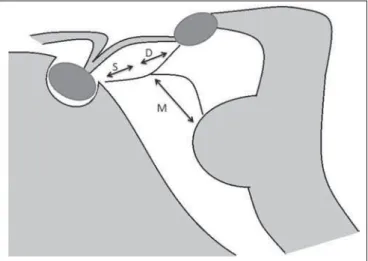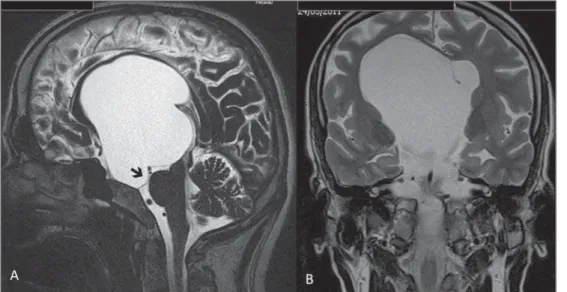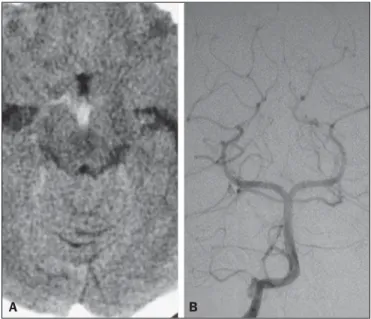Dias DA et al. / Liliequist membrane: radiological evaluation
Radiol Bras. 2014 Mai/Jun;47(3):182–185 182
0100-3984 © Colégio Brasileiro de Radiologia e Diagnóstico por Imagem
Iconographic Essay
Liliequist membrane: radiological evaluation, clinical
and therapeutic implications
*
Membrana de Liliequist: avaliação radiológica e suas implicações clínicas e terapêuticas
Dias DA, Castro FLO, Yared JH, Lucas Júnior A, Ferreira Filho LA, Ferreira NFPD. Liliequist membrane: radiological evaluation, clinical and therapeutic implications. Radiol Bras. 2014 Mai/Jun;47(3):182–185.
Abstract
R e s u m o
In a simplistic and succinct way, Liliequist membrane may be understood as a projection formed by an arachnoid membrane extending from the dorsum sellae to the mammillary bodies. In spite of being well known to neurosurgeons, many radiologists neither know this anatomical structure nor give importance to its study. The imaging evaluation of this membrane is feasible and may be interesting for a better preoperative planning; postoperative evaluation of third ventriculostomies; and understanding of suprasellar arachnoid cysts and perimesencephalic hemorrhage. The present article illustrates the anatomy of the membrane, with emphasis on imaging findings, besides describing its possible clinical and surgical implications.
Keywords: Membrane; Liliequist; Third ventriculostomy; Magnetic resonance imaging; Neuroradiology.
A membrana de Liliequist, de maneira simplista e sucinta, pode ser entendida como uma projeção formada pela aracnoide que se estende do dorso da sela turca aos corpos mamilares. Apesar de se tratar de uma estrutura anatômica bem conhecida pelos neuroci-rurgiões, muitos radiologistas não a conhecem ou não valorizam seu estudo. A avaliação por imagem desta membrana é factível e pode ser interessante para o melhor planejamento pré-operatório, avaliação pós-operatória de terceiro-ventriculostomias e entendimento dos cistos aracnoides suprasselares e hemorragias perimesencefálicas. Ilustramos neste artigo os aspectos anatômicos da membrana, sobretudo do ponto de vista de imagem, além de suas possíveis implicações clinicocirúrgicas.
Unitermos: Membrana; Liliequist; Terceiro-ventriculostomia; Ressonância magnética; Neurorradiologia.
* Study developed at Hospital do Coração (HCor)-Associação do Sanatório Sírio e Teleimagem, São Paulo, SP, Brazil.
1. MDs, Neuroradiology and Head & Neck Fellows at Hospital do Coração (HCor) and Teleimagem, São Paulo, SP, Brazil.
2. MD, Neuroradiologist at Hospital do Coração (HCor) and Teleimagem, São Paulo, SP, Brazil.
3. MD, Neuroradiologist at Hospital do Coração (HCor), Teleimagem, and Alta, São Paulo, SP, Brazil.
4. MD, Neuroradiologist and Head & Neck Radiology, Hospital do Coração (HCor), Teleimagem, and Alta, São Paulo, SP, Brazil.
5. MD, Head of the Neuroradiology Unit at Hospital do Coração (HCor), Teleima-gem, and Alta, São Paulo, SP, Brazil.
Mailing Address: Dr. Daniel Aguiar Dias. Rua Deputado Moreira da Rocha, 500, ap. 1600, Meireles. Fortaleza, CE, Brazil, 60160-060. E-mail: daniel_aguiar@ hotmail.com.
Received May 28, 2013. Accepted after revision September 9, 2013.
about this structure is justified with a view on its several clini-cal and surgiclini-cal implications, among them: a better preop-erative planning; a possible failure of endoscopic ventricu-lar shunt; and the clinical presentation of supraselventricu-lar arach-noid cysts and perimesencephalic hemorrhages(1,2).
The relevance of a preoperative imaging evaluation of the LM is still to be established, in spite of the fact that studies report its feasibility, besides its positive influence on surgi-cal outcomes(3).
ANATOMY AND RADIOLOGICAL FINDINGS
The LM can be identified as a thin structure (≤ 1 mm) with a thickness that is ever inferior to that of the tuber cinereum, located under the floor of the third ventricle, an-teriorly extending from the dorsum sellae to the mammill-ary bodies. It may be considered a remnant of the primmammill-ary tentorium, formed by either a single or double arachnoid layer and divided into three segments, as shown on Figures 1 and 2: the sellar, diencephalic and mesencephalic segments. The sellar segment is the most frequently seen on imaging methods, followed by the diencephalic and mesencephalic segments(1), and the latter two segments are also less
fre-quently isolated in studies with cadavers(2). Such a finding can be explained by the fact that, as a rule, the mesencepha-lic segment is incomplete, thinner and presents a fenestra-tion through which the basilar artery passes.
Daniel Aguiar Dias1, Fábio Luiz Onuki Castro2, James Henrique Yared3, Ademar Lucas Júnior4, Luiz Alves
Ferreira Filho1, Nelson Fortes Paes Diniz Ferreira5
INTRODUCTION
Liliequist membrane (LM) is a complex and variable structure. Initially described by Key and Retzius in 1875, it was further investigated by Liliequist in 1956 in his studies with pneumoencephalography in cadavers, and is well known by neurosurgeons. An increasing interest has been observed in relation to the study of Liliequist membrane, with the improvement and dissemination of minimally invasive en-doscopic surgical techniques(1).
In spite of being poorly recognized in the radiological community, the imaging evaluation of such a membrane is feasible in the greatest part of cases(1,2), and the knowledge
Dias DA et al. / Liliequist membrane: radiological evaluation
Radiol Bras. 2014 Mai/Jun;47(3):182–185 183
In most cases reviewed in the literature, the membrane presents lateral insertions into the oculomotor nerves or adjacent to them, generally into the circumjacent arachnoid sheaths (Figure 3). The posterior anchoring is controver-sial, particularly in cases of retromammillary or premammil-lary insertion(1,2).
Also, it is important to note that, principally because of its diencephalic component, the LM isolates the interpedun-cular cistern from the chiasmatic cistern, with complete blockage in about 10-30% of cases. This fact is clinically relevant and, for this reason, it will be explored further.
The thin membrane structure may be better evaluated by means of specific sequences with high contrast and
ana-tomic resolution. For such a purpose, constructive interfer-ence in steady state (CISS) sequinterfer-ences, because of their cisternography effect, stands out as the best option, and is currently the imaging method of choice to evaluate cranial nerves, analyze cysts, cystic masses, neurocysticercosis and hydrocephalus. CISS is included in the family of fast gradi-ent echo (GRE) sequences and presents different names ac-cording to the apparatus manufacturer: it is called fast imag-ing employimag-ing steady state acquisition (FIESTA) by General Electric, true fast imaging with steady-state precession (FISP) by Siemens, balanced fast field echo (FFE) by Philips, and true steady-state free precession (SSFP) by Toshiba(4).
CLINICAL AND SURGICAL RELEVANCE Surgical implications
Occlusion caused by the LM or even by other pre-pon-tine arachnoid trabeculae is already a well established cause of failure of endoscopic third-ventriculostomy, a surgical approach classically utilized for obstructive hydrocephalus resulting from aqueductal stenosis. It is important to note that, most recently, such a technique has also been utilized in some selected cases of non-obstructive hydrocephalus, with basis on new hydrodynamic concepts of the cerebrospi-nal fluid (CSF) flow, among them the case of relative aqueductal stenosis(5).
In such a procedure, the neurosurgeon performs the puncture of the floor of the third ventricle, by direct visual-ization, communicating the third ventricle with the basal cisterns. Intraoperatively, the CSF flow can already be seen through the orifice. Also, in order to guarantee the success Figure 1. Schematic illustration of the LM anatomy, demonstrating the three
segments of the Liliequist membrane in the sagittal plane. S, sellar segment; M, mesencephalic segment; D, diencephalic segment. (Modified by Fushimi et al.(1)).
Figure 2. Radiological anatomy. Sagittal (slightly paramedian) CISS image clearly demonstrating the LM and its three segments. Note the membrane insertion into the mammillary body, and its thickness much inferior to that of the third ventricle floor. The white arrow identifies the sellar segment; the black arrow, the dien-cephalic segment; and the arrow head, the mesendien-cephalic segment.
Dias DA et al. / Liliequist membrane: radiological evaluation
Radiol Bras. 2014 Mai/Jun;47(3):182–185 184
of the treatment, it is necessary to create a patent pathway from the interpeduncular and pre-pontine cisterns to the chiasmatic/suprasellar cistern. In case the flow between the cisterns is not visualized, one can suspect of imperforate LM, and fenestration may be performed in the same surgical ses-sion, if feasible. In such a context, it is important to note that a preoperative evaluation of the local anatomy, includ-ing an investigation and analysis of the arachnoid membranes could offer further information for the surgical planning.
At the post-procedural imaging evaluation, one can vi-sualize the CSF flow through the shunt, characterized by the presence of intense flow artifact (flow-void). In such a case flow contrast techniques (phase contrast) can be utilized, allowing for the analysis of the pulsatility of the cerebrospi-nal fluid flow, besides the possibility of measuring the stroke volume. It is important to note that the follow-up of ventricu-lar dimensions do not represent a reliable parameter in the evaluation of the stomy patency.
In case a dysfunctional the ventriculostomy orifice is evidenced either on the basis of clinical or imaging findings, an evaluation with 3D-CISS magnetic resonance imaging (MRI) may be extremely useful, since this method can dif-ferentiate between ventriculostomy orifice occlusion (gen-erally by cicatricial tissue) and eventual mechanical obstruc-tion by the LM and/or other arachnoid trabeculae in the pre-pontine cistern, according to the example illustrated on Fig-ure 4(3,5,6).
Suprasellar arachnoid cysts
Another condition whose genesis is intimately related to LM is suprasellar arachnoid cyst that may be understood as an imperforate LM invagination or diverticulum, with progressive accumulation of liquor cerebrospinalis. Thus, a cystic mass originates in the suprasellar cistern and may even herniate through the floor of the third ventricle and then towards the foramen of Monro, therefore causing obstruc-tive hydrocephalus (Figure 5).
Besides the clinical condition of obstructive hydroceph-alus, the symptoms are related to the typical mass effect of suprasellar lesions (visual disorders and endocrinological dysfunctions related to hypothalamic-hypophyseal axis dys-function). Although this is a rare and nonspecific presenta-tion, the classical bobble-head doll syndrome is described and many times may be erroneously interpreted as a tic in small children.
The imaging findings may be the same as those of arach-noid cysts in other regions, characterized as thin walled cys-tic masses with a content isodense/isointense to the CSF on all the acquisitions and no enhancement after contrast me-dium injection. The absence of fat and hypersignal on diffu-sion weighted image (DWI) is useful in the eventual differ-entiation with dermoid and epidermoid cysts, respectively. The treatment of suprasellar cysts has advanced in the last years with the employment of minimally invasive endo-scopic techniques, notwithstanding the controversy about the best procedure to be adopted (ventriculocystostomy versus ventriculocistocisternostomy)(7).
Figure 4. Failure of third-ventriculostomy. Postoperative image of endoscopic third-ventriculostomy. The presence of an intense flow artifact through the cere-bral acqueduct toward the fourth ventricle is highlighted. Note the absence of flow identifiable by ventriculostomy orifice in the third ventricle, that is patent and wide (white arrow). Note the membrane in the pre-pontine cistern (black arrow) that may correspond to the lowered, intact Liliequist membrane or even pre-pontine membrane. Also, a remarkable global dilatation of the ventricular system is ob-served, probably resulting from obstruction at the level of the fourth ventricle out-put pathways where no sign of liquor cerebrospinalis flow is observed.
Dias DA et al. / Liliequist membrane: radiological evaluation
Radiol Bras. 2014 Mai/Jun;47(3):182–185 185
Perimesencephalic hemorrhages
Still, in relation to the relevant clinical implications, it is important to highlight the nonaneurysmal perimesence-phalic hemorrhage. Some authors suggest that a more ap-propriate term for such a condition would be “nonaneurysmal pre-brainstem hemorrhage” since, generally, the bleeding epicenter is located anteriorly to the pre-pontine cistern. However, such bleedings may be seen at any point in the perimesencephalic cistern, as shown on Figure 6.
In the case of such a condition, the previously described anatomical aspects acquire special significance, since they explain its physiopathology and diagnostic criteria. Perimesencephalic hemorrhage is a bleeding of uncertain etiology, but that is probably related to rupture of small perimesencephalic or capillary veins.
In contrast to the more exuberant clinical signs observed in patients with aneurysm rupture and consequential sub-arachnoid hemorrhage, patients with nonaneurysmal perimesencephalic hemorrhage present with a milder ictus, marked by headache, meningism, photofobia and nausea, and, rarely, loss of consciousness.
In principle, such a condition has a more favorable prog-nosis than subarachnoid bleedings secondary to aneurysm rupture, and complications such as rebleeding and vasospasm are less frequently observed.
From the imaging diagnosis point of view, it is empha-sized that, in general, the hematic material remains under the LM, i.e., in the perimesencephalic cistern (subdivided
into interpeduncular, crural, ambient and quadrigeminal cisterns) and/or pre-pontine cistern. A significant amount of blood cranially flowing through the membrane towards the chiasmatic/suprasellar, Silvian or inter-hemispheric cisterns should be viewed with suspicion, i.e., the diagnostic possi-bility of aneurysmal rupture should be considered.
Angiography is mandatory to rule out the presence of aneurysm, because about 3% of patients with basilar bifur-cation aneurysm rupture meet the mentioned imaging crite-ria for nonaneurysmal perimesencephalic hemorrhage. The necessity of a second angiography is still discussed if an angiogram is negative, particularly in dubious cases or in high-risk patients(8).
Therefore, the presence of a bleeding under the LM suggests the diagnosis of such a condition that has a distinc-tive physiopathological process and better prognosis than basal cistern hemorrhages secondary to aneurysmal rupture.
CONCLUSION
The knowledge about LM by radiologists is extremely relevant, either for a better understanding of the several re-lated conditions, or even for an appropriate integration and dialogue with the requesting physician/surgeon. Further-more, the recent advances of neurosurgical endoscopic tech-niques have renewed the enthusiasm for the study of the LM. Also, it is important to note that the introduction of high-detailing MRI techniques allows for a better evaluation and understanding of the anatomical particularities of such a structure.
REFERENCES
1. Fushimi Y, Miki Y, Ueba T, et al. Liliequist membrane: three-dimen-sional constructive interference in steady state MR imaging. Radiol-ogy. 2003;229:360–5.
2. Froelich SC, Abdel Aziz KM, Cohen PD, et al. Microsurgical and endoscopic anatomy of Liliequist’s membrane: a complex and vari-able structure of the basal cisterns. Neurosurgery. 2008;63(1 Suppl 1):ONS1–8.
3. Anýk I, Ceylan S, Koc K, et al. Membranous structures affecting the success of endoscopic third ventriculostomy in adult aqueductus sylvii stenosis. Minim Invasive Neurosurg. 2011;54:68–74.
4. Gonçalves FG, do Amaral LLF. Constructive interference in steady state imaging in the central nervous system. European Neurological Review. 2011;6:138–42.
5. Gangemi M, Maiuri F, Naddeo M, et al. Endoscopic third ventricu-lostomy in idiopathic normal pressure hydrocephalus: an Italian multicenter study. Neurosurgery. 2008;63:62–7.
6. Bargalló N, Olondo L, Garcia AI, et al. Functional analysis of third ventriculostomy patency by quantification of CSF stroke volume by using cine phase-contrast MR imaging. AJNR Am J Neuroradiol. 2005;26:2514–21.
7. El-Ghandour NM. Endoscopic treatment of suprasellar arachnoid cysts in children. J Neurosurg Pediatr. 2011;8:6–14.
8. Greenberg M. Handbook of neurosurgery. 7th ed. New York: Thieme; 2010.
Figure 6. Perimesencephalic hemorrhage. Spontaneously hyperdense hematic material at the level of the interpeduncular cistern (non-contrast-enhanced com-puted tomography – image on A). Digital subtraction angiography (image on B) did not demonstrate any aneurysmal malformation (in this case, for illustrative pur-poses, demonstrating only the posterior circulation).


